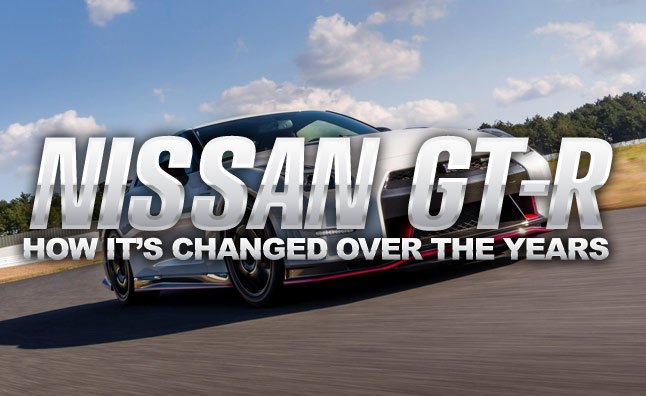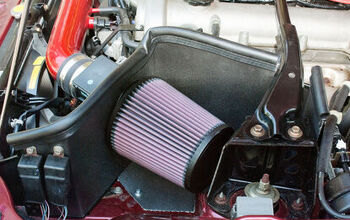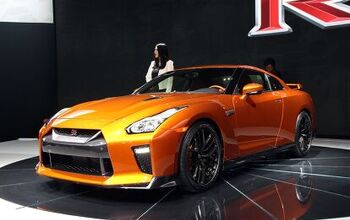By the Numbers: How the Nissan GT-R Has Changed

Ever since it burst onto the scene in 2008, the Nissan GT-R has been a force to be reckoned with.
Heralded and acclaimed as one of the greatest sports cars to ever come from Japan when it first debuted, Nissan has continued to give its famed GT-R model tweaks and changes over the years, making it even more formidable. To pay our respects to one of the greatest machines any automotive enthusiast can buy in today’s marketplace, AutoGuide has decided to take a look at the Nissan GT-R over the years, how it’s changed inside and out, along with its price tag.
For years, North American automotive enthusiasts yearned for the Nissan Skyline GT-R. That finally happened in 2009 with the R35 Skyline debuting, but without the Skyline name.
The GT-R made its official worldwide debut at the Tokyo Motor Show in October 2007 before it was introduced in North America at the 2007 Los Angeles Auto Show. It didn’t start arriving at dealerships in the U.S. until June 2008 as a 2009 model year, but by then, the hype surrounding the car was already in full gear. Powered by a 3.8-liter twin-turbo V6 engine, the GT-R was introduced with 480 hp and 430 lb-ft of torque mated to a six-speed dual-clutch transmission with all-wheel drive.
But it wasn’t just power that made the GT-R such an attractive piece of machinery. The Japanese automaker stressed that its aerodynamics, suspension and handling capabilities made it a race car for the road, a saying that would follow the model for years to come. Boasting a 7:38 Nurburgring lap time, the 2009 GT-R hit the U.S. market with a starting price tag of $70,850 including delivery for the Base model while the Premium model was priced from $72,900. In September 2008, Nissan adjusted the price of the 2009 GT-R to $77,840 for the Base model and $80,090 for the Premium model due to “increased raw materials costs,” but the pricing didn’t affect those that placed orders prior to September 5.
2009 Nissan GT-R
Horsepower: 480 hp
Torque: 430 lb-ft
Price: $70,850
Nurburgring Lap Time: 7:38
2009.5 Nissan GT-R
Horsepower: 480 hp
Torque: 430 lb-ft
Price: $77,840 (9.87% increase vs. 2009)
After gathering a year of accolades and media attention, the 2010 Nissan GT-R saw a slight bump in performance to 485 hp and 434 lb-ft of torque while the base model now came equipped with slightly darker, smoke finish 20-inch wheels from Rays. The Premium model received a near-black metallic wheel finish and a Pearl White shade was offered for the new model year. The rest of the vehicle remained mostly unchanged, though its suspension was further refined and it received standard front seat- and roof-mounted curtain side-impact supplement air bags. Pricing saw a bump to $81,790 for the Base model while the Premium model was priced from $84,040.
2010 Nissan GT-R
Horsepower: 485 hp (1.04% increase vs 2009)
Torque: 434 lb-ft (0.93% increase vs 2009)
Price: $81,790 (15.44% increase vs 2009, 5.07% increase year-over-year)
In year three, Nissan once again re-tuned its suspension and the lineup was simplified to offer the Nissan GT-R Premium model. The powertrain remained untouched for 2011 but the Japanese automaker added slightly darker wheel center caps, double clear coat on the front and rear bumpers as well as rear cooling ducts to improve cooling performance around the rear floor area. Becoming standard on the Premium model was auto on/off headlights and speed-sensitive windshield wipers in addition to USB iPod interface, Streaming Audio via Bluetooth and DVD playback to the Navigation system.
Once again, the 2011 Nissan GT-R Premium saw its price increased to $85,060, an increase of $1,020 over the 2010 Nissan GT-R Premium.
2011 Nissan GT-R
Horsepower: 485 hp
Torque: 434 lb-ft
Price: $85,060 (20.06% increase vs 2009, 4.00% increase year-over-year)
Nurburgring Lap Time: 7:24.22
When the 2012 model year GT-R arrived, it was the first time the model received “significant” changes with a new look, new colors, new wheel design and a boost in performance. The same 3.8-liter twin-turbo powerplant was massaged to churn out 530 hp now instead of 485 hp and its torque was increased 10 lb-ft to 448 lb-ft. In addition, its aerodynamics were slightly improved with downforce increased by about 10 percent resulting in its coefficient of drag reducing from 0.27 to 0.26.
Despite the increase in performance, the 2012 Nissan GT-R was actually more fuel efficient getting 16 mpg in the city and 23 mpg on the highway, versus the previous 15-mpg city, 21-mpg highway ratings. The front end received DRLs along with an enlarged opening that helped reduce air resistance inside the engine compartment. The result was an increased volume of air that passed through the radiator as well as that which cooled the front brakes.
Rays once again contributed the wheels on the 2012 GT-R, but this time around they were lighter and more rigid, while the automaker added the new Black Edition to the lineup. Making it unique, the GT-R Black Edition featured special metallic black six-spoke Rays wheels, custom red and black Recaro leather seats, red and black interior trim and a dark headliner.
The 2012 Nissan GT-R Premium was priced from $90,950 while the Nissan GT-R Black Edition had a starting price tag of $96,100.
2012 Nissan GT-R
Horsepower: 530 hp (10.42% increase vs 2009, 9.28% increase year-over-year)
Torque: 448 lb-ft (4.19% increase vs 2009, 3.23% increase year-over-year)
Price: $90,950 (28.37% increase vs 2009, 6.92% increase year-over-year)
But the Japanese automaker was hardly finished with its sports car. Gathering data through all its motorsports campaigns with the GT-R, Nissan continued to improve the performance of the GT-R to 545 hp for the 2013 model year, an increase of 15 hp. Torque was improved the same value to 463 lb-ft. Other improvements made to the 2013 Nissan GT-R included a strengthened design of the shift fork arm and a firmer fixing bearing for the flywheel housing. High performance differential oil also became standard for production models, which is the same stuff used in GT-R motorsports competition.
And of course the suspension was further refined while the GT-R Black Edition gained a handmade, dry-carbon rear spoiler. Other minor enhancements for the 2013 GT-R were the addition of a new blue lighting treatment inside the tachometer ring to match the shift position indicator light and a RearView monitor became standard for all models.
That year, the GT-R saw a major bump in its pricing with the Premium model starting from $97,820 and the Black Edition priced from $107,320.
2013 Nissan GT-R
Horsepower: 545 hp (13.54% increase vs 2009, 2.83% increase year-over-year)
Torque: 463 lb-ft (7.67% increase vs 2009, 3.35% increase year-over-year)
Price: $97,820 (38.07% increase vs 2009, 7.55% increase year-over-year)
Nurburgring Lap Time: 7:19.10
Following a significant increase in performance for the 2013 model year GT-R, the Japanese automaker continued to tweak the 2014 GT-R with new fuel injectors for enhanced torque response helping improve throttle and acceleration in the sports car’s mid- to high-rpm ranges. An oil pan baffle was also added to stabilize oil behavior and oil pressure under harsh driving conditions. For the 2014 model year, Nissan also added an aluminum nameplate to each engine to signify which technician out of the total four that hand-built the powerplant for that specific vehicle.
A new premium interior was also introduced for the 2014 model year that featured a change in color and stitching for a higher quality look and feel. The Black Edition model’s steering wheel received coordinated red accents for a sportier appearance. The 2014 model year GT-R also introduced the Track Edition model that features a specially tuned suspension, special brake cooling guides, front spoiler with carbon fiber air ducts and a lightweight quilted cloth mat where the rear seats used to be.
The 2014 Nissan GT-R Premium had a starting price of $100,590 while the Black Edition was priced from $110,330. Those looking for the lightweight Track Edition had to be ready to shell out at least $116,710.
2014 Nissan GT-R
Horsepower: 545 hp
Torque: 463 lb-ft
Price: $100,590 (41.98% increase vs 2009, 2.83% increase year-over-year)
Now in its 2015 model year, the GT-R has transformed once again with a recalibrated suspension for a more sophisticated ride and better road holding, new LED headlights and distinctive front and rear end designs while the Track Edition gains a carbon fiber trunk lid. While the Premium, Black and Track Edition models still feature 545 hp and 463 lb-ft of torque, the 2015 Nissan GT-R also sees the NISMO model added to the lineup. With a starting price of $151,585, the Nissan GT-R NISMO boasts 600 hp and 481 lb-ft of torque to go along with its enhanced aerodynamics, body reinforcement and ultra-precise handling.
Pricing for the 2015 Nissan GT-R Premium starts at $103,365 while the Black Edition is priced from $113,105. The Track Edition will be offered starting July 31 at $117,305.
So over the span of a few years, the GT-R has gone from a 480-hp, 430 lb-ft of torque machine with a starting price of $77,840 to offering a NISMO variant with 600 hp and 481 lb-ft of torque with a starting price of $151,585; nearly double the original price.
What’s next for the GT-R? It’s clear that Nissan wants to continue to refine the current model as it prepares for its next-generation machine, a vehicle that is rumored to be hybrid powered to make it even more formidable. If the history of the GT-R has taught us anything, there’s always room for improvement and nothing is ever perfect.
2015 Nissan GT-R
Horsepower: 545 hp
Torque: 463 lb-ft
Price: $103,365 (45.89% increase vs 2009, 2.76% increase year-over-year)
2015 Nissan GT-R NISMO
Horsepower: 600 hp (25% increase vs 2009, 10.09% increase vs. base 2015 model)
Torque: 481 lb-ft (11.86% increase vs 2009, 3.89% increase vs. base 2015 model)
Price: $151,585 (113.95% increase vs 2009, 46.65% increase vs. base 2015 model)
Nurburgring Lap Time: 7:08.68

Jason Siu began his career in automotive journalism in 2003 with Modified Magazine, a property previously held by VerticalScope. As the West Coast Editor, he played a pivotal role while also extending his expertise to Modified Luxury & Exotics and Modified Mustangs. Beyond his editorial work, Jason authored two notable Cartech books. His tenure at AutoGuide.com saw him immersed in the daily news cycle, yet his passion for hands-on evaluation led him to focus on testing and product reviews, offering well-rounded recommendations to AutoGuide readers. Currently, as the Content Director for VerticalScope, Jason spearheads the content strategy for an array of online publications, a role that has him at the helm of ensuring quality and consistency across the board.
More by Jason Siu








































Comments
Join the conversation
You're comparing the base model to the base NISMO. Who writes this garbage?